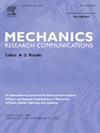循环神经网络作为一种基于物理学的自学习求解器,满足各向同性损伤下的平面应力粘塑性要求
IF 1.9
4区 工程技术
Q3 MECHANICS
引用次数: 0
摘要
本研究介绍了一种基于递归神经网络的新型自学习框架,用于计算板结构在受到各向同性损伤时的非线性粘塑性响应。由 Legendre Memory Unit (LMU) 单元和密集变换组成的神经网络通过数据驱动和基于物理的损失函数组合进行预训练。预训练完成后,在显式积分方案中部署该模型,以预测满足平面应力条件的厚度方向上的应变增量。这就消除/减少了满足平面应力条件所需的迭代次数,并且由于神经网络取代了寻根方法,因此收敛速度更快。提出的自学习方法有别于著名的物理信息神经网络(PINNs),因为神经网络模型通过提出的基于物理的损失项在线自学习,无需数据。我们比较了神经网络增强积分方案与经典显式积分方案的结果,以验证所提方法的有效性。本文章由计算机程序翻译,如有差异,请以英文原文为准。
Recurrent neural networks as a physics-based self-learning solver to satisfy plane stress viscoplasticity undergoing isotropic damage
The present study introduces a new self-learning framework based on a recurrent neural network to compute the nonlinear viscoplastic response of plate structures undergoing isotropic damage. The neural network comprising Legendre Memory Unit (LMU) cells and dense transformations is pretrained with a combination of data-driven and physics-based loss functions. Once pretrained, the model is deployed in the explicit integration scheme to predict the strain increment in the thickness direction satisfying plane stress condition. This results in elimination/reduction in the iterations required to fulfill the plane stress condition and leads to faster convergence since the neural network replaces the root-finding methods. The proposed self-learning method differentiates itself from the well-known Physics-Informed Neural Networks (PINNs) since the neural network model self-learns online through the proposed physics-based loss term without the need for data. We compare the results of the Neural Network-enhanced integration scheme to validate the proposed method with those of the classical explicit integration scheme.
求助全文
通过发布文献求助,成功后即可免费获取论文全文。
去求助
来源期刊
CiteScore
4.10
自引率
4.20%
发文量
114
审稿时长
9 months
期刊介绍:
Mechanics Research Communications publishes, as rapidly as possible, peer-reviewed manuscripts of high standards but restricted length. It aims to provide:
• a fast means of communication
• an exchange of ideas among workers in mechanics
• an effective method of bringing new results quickly to the public
• an informal vehicle for the discussion
• of ideas that may still be in the formative stages
The field of Mechanics will be understood to encompass the behavior of continua, fluids, solids, particles and their mixtures. Submissions must contain a strong, novel contribution to the field of mechanics, and ideally should be focused on current issues in the field involving theoretical, experimental and/or applied research, preferably within the broad expertise encompassed by the Board of Associate Editors. Deviations from these areas should be discussed in advance with the Editor-in-Chief.

 求助内容:
求助内容: 应助结果提醒方式:
应助结果提醒方式:


